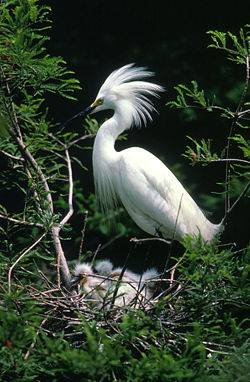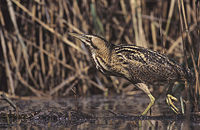Heron
| Heron | ||||||||||
|---|---|---|---|---|---|---|---|---|---|---|
 Snowy Egret, Egretta thula. Note the chicks in the nest.
| ||||||||||
| Scientific classification | ||||||||||
| ||||||||||
|
See text. |
The herons are wading birds in the Ardeidae family. Some are called egrets or bitterns instead of herons. Within the family, all members of the genera Botaurus and Ixobrychus are referred to as bitterns, and—including the Zigzag Heron or Zigzag Bittern—are a monophyletic group within the Ardeidae. However, egrets are not a biologically distinct group from the herons, and tend to be named differently because they are mainly white or have decorative plumes.
The classification of the individual heron/egret species is fraught with difficulty, and there is still no clear consensus about the correct placement of many species into either of the two major genera, Ardea and Egretta. Similarly, the relationship of the genera in the family is not completely resolved. For example, the Boat-billed Heron is sometimes classed as a heron, and sometimes given its own family Cochlearidae, but nowadays it is usually retained in the Ardeidae.
Although herons resemble birds in some other families, such as the storks, ibises and spoonbills, they differ from these in flying with their necks retracted, not outstretched. They are also one of the bird groups that have powder down.
The members of this family are mostly associated with wetlands, and prey on fish, frogs and other aquatic species. Some, like the Cattle Egret and Black-headed Heron, also take large insects, and are less tied to watery environments. Some members of this group nest colonially in trees, others, notably the bitterns, use reedbeds.
In February 2005, the Canadian scientist Dr. Louis Lefebvre announced a method of measuring avian IQ in terms of their innovation in feeding habits. Herons were named among the most intelligent birds based on this scale, reflecting a wide variety, flexibility and adaptiveness to acquire food[citation needed].
Taxonomy
Analyses of the skeleton, mainly the skull, suggested that the Ardeidae could be split into a diurnal and a crepuscular/nocturnal group which included the bitterns. From DNA studies and skeletal analyses focusing more on bones of body and limbs, this grouping has been revealed as incorrect (McCracken & Sheldon 1998). Rather, the similarities in skull morphology reflect convergent evolution to cope with the different challenges of daytime and nighttime feeding. Today, it is believed that three major groups can be distinguished (Sheldon et al. 1995, 2000), which are (from the most primitive to the most advanced):
- tiger herons and the boatbill
- bitterns
- day-herons and egrets, and night-herons
The night herons could warrant separation as subfamily Nycticoracinae, as it was traditionally done. However, the position of some genera (e.g. Butorides or Syrigma) is unclear at the moment, and molecular studies have until now suffered from a small number of studied taxa. Especially the relationship among the ardeine subfamily is very badly resolved. The arrangement presented here should be considered provisional.
FAMILY ARDEIDAE
Subfamily Tigrisomatinae
- Genus Cochlearius -
- Boat-billed Heron, Cochlearius cochlearius
- Genus Tigrisoma
- Bare-throated Tiger Heron, Tigrisoma mexicanum
- Fasciated Tiger Heron, Tigrisoma fasciatum
- Rufescent Tiger Heron, Tigrisoma lineatum
- Genus Tigriornis
- White-crested Tiger Heron, Tigriornis leucolophus
- Genus Zonerodius
- New Guinea Tiger Heron, Zonerodius heliosylus
Subfamily Botaurinae
- Genus Zebrilus
- Zigzag Heron, Zebrilus undulatus
- Genus Ixobrychus - small bitterns (8 living species, 1 recently extinct)
- Genus Botaurus - large bitterns (4 species)
Subfamily Ardeinae
- Genus Zeltornis (fossil)
- Genus Nycticorax (2-4 living species, 5 recently extinct; includes Nyctanassa)
- Genus Gorsachius (3-5 species)
- Genus Butorides (3 species; sometimes included in Ardea)
- Genus Agamia - Agami Heron
- Genus Pilherodius
- Capped Heron, Pilherodius pileatus
- Genus Ardeola (6 species)
- Genus Bubulcus - Cattle Egret (sometimes included in Ardea)
- Genus Proardea (fossil)
- Genus Ardea - typical herons (11-17 species)
- Genus Syrigma
- Whistling Heron, Syrigma sibilatrix
- Genus Egretta - typical egrets (7-13 species)
- Genus undetermined
- Easter Island Heron, Ardeidae gen. et sp. indet. (prehistoric)
Fossil species of unresolved affiliations:
- Xenerodiops (Early Oligocene of Fayyum, Egypt)
- Ardeagradis
- Calcardea
- Proardeola - possibly same as Proardea
Other prehistoric and fossil species are included in the respective genus accounts.
Trivia
The Norwegian municipalities of Forsand and Tysvær have herons in their coat-of-arms.
On the 30th April 2007 two herons were ingested into the engine of a Boeing 757 on departure from Manchester Airport. The pilot shut down the damaged engine and landed safely.
In the Wheel of Time series of books a heron-marked sword is a sign of a blademaster.
See also
- Bennu
ReferencesISBN links support NWE through referral fees
- McCracken, Kevin G. & Sheldon, Frederick H. (1998): Molecular and osteological heron phylogenies: sources of incongruence. Auk (journal) 115: 127–141. PDF fulltext
- Sheldon, Frederick H.; McCracken, Kevin G. & Stuebing, Keeley D. (1995): Phylogenetic relationships of the zigzag heron (Zebrilus undulatus) and white-crested bittern (Tigriornis leucolophus) estimated by DNA-DNA hybridization. Auk 112(3): 672-679. PDF fulltext
- Sheldon, Frederick H.; Jones, Clare E. & McCracken, Kevin G. (2000): Relative Patterns and Rates of Evolution in Heron Nuclear and Mitochondrial DNA. Molecular Biology and Evolution 17(3): 437–450. PDF fulltext
External links
- Heron videos on the Internet Bird Collection
Credits
New World Encyclopedia writers and editors rewrote and completed the Wikipedia article in accordance with New World Encyclopedia standards. This article abides by terms of the Creative Commons CC-by-sa 3.0 License (CC-by-sa), which may be used and disseminated with proper attribution. Credit is due under the terms of this license that can reference both the New World Encyclopedia contributors and the selfless volunteer contributors of the Wikimedia Foundation. To cite this article click here for a list of acceptable citing formats.The history of earlier contributions by wikipedians is accessible to researchers here:
The history of this article since it was imported to New World Encyclopedia:
Note: Some restrictions may apply to use of individual images which are separately licensed.



